HONDA CIVIC SEDAN 2013 Owner's Manual (in English)
Manufacturer: HONDA, Model Year: 2013, Model line: CIVIC SEDAN, Model: HONDA CIVIC SEDAN 2013Pages: 368, PDF Size: 43.54 MB
Page 341 of 368
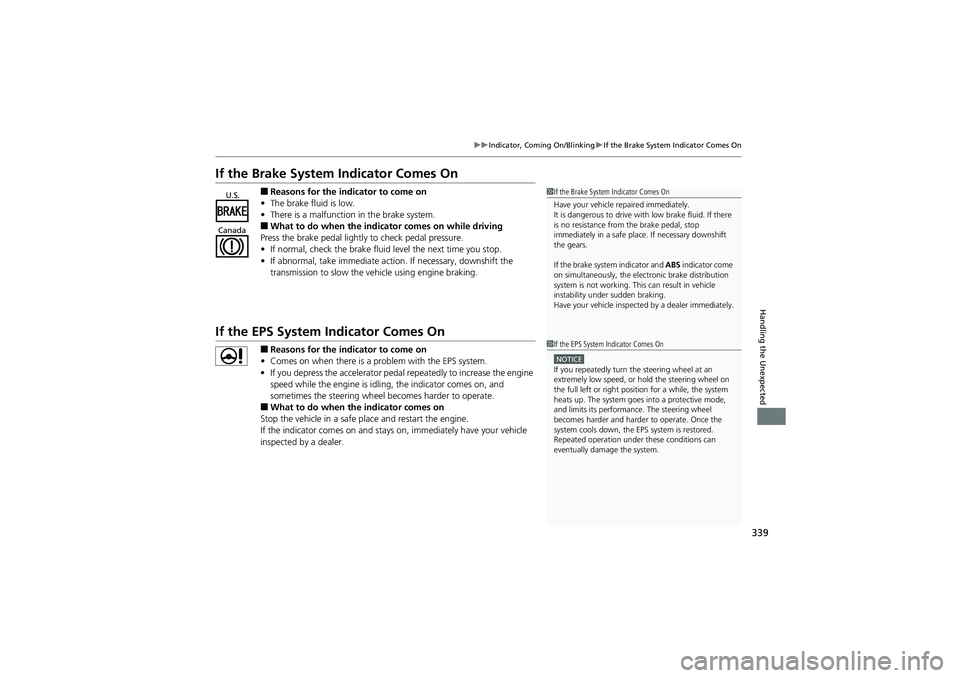
339
uuIndicator, Coming On/Blinking uIf the Brake System Indicator Comes On
Handling the Unexpected
If the Brake System Indicator Comes On
■Reasons for the indicator to come on
• The brake fluid is low.
• There is a malfunction in the brake system.
■What to do when the indicator comes on while driving
Press the brake pedal lightly to check pedal pressure.
• If normal, check the brake fluid level the next time you stop.
• If abnormal, take immediate action. If necessary, downshift the
transmission to slow the vehicle using engine braking.
If the EPS System Indicator Comes On
■Reasons for the indicator to come on
• Comes on when there is a problem with the EPS system.
• If you depress the accelerator pedal repeatedly to increase the engine
speed while the engine is idlin g, the indicator comes on, and
sometimes the steering wheel becomes harder to operate.
■What to do when the indicator comes on
Stop the vehicle in a safe place and restart the engine.
If the indicator comes on and stays on, immediately have your vehicle
inspected by a dealer.
1 If the Brake System Indicator Comes On
Have your vehicle repaired immediately.
It is dangerous to drive with low brake fluid. If there
is no resistance from the brake pedal, stop
immediately in a safe plac e. If necessary downshift
the gears.
If the brake system indicator and ABS indicator come
on simultaneously, the electronic brake distribution
system is not working. This can result in vehicle
instability under sudden braking.
Have your vehicle inspected by a dealer immediately.U.S.
Canada
1 If the EPS System Indicator Comes On
NOTICEIf you repeatedly turn the steering wheel at an
extremely low speed, or hold the steering wheel on
the full left or right position for a while, the system
heats up. The system goes into a protective mode,
and limits its performance. The steering wheel
becomes harder and harder to operate. Once the
system cools down, the EPS system is restored.
Repeated operation unde r these conditions can
eventually damage the system.
Page 342 of 368

340
uuIndicator, Coming On/Blinking uIf the Low Tire Pressure/TPMS Indicator Comes On or Blinks
Handling the Unexpected
If the Low Tire Pressure/TPMS Indicator Comes On or
Blinks
■Reasons for the indicator to come on or blink
A tire pressure is significantly low. If there is a problem with the TPMS or
the compact spare tire
* is installed, the indica tor blinks for about one
minute, and then stays on.
■What to do when the indicator comes on
Stop your vehicle in a safe place. Check the tire pressure and adjust the
pressure to the specified level. The specified tire pressure is on a label on
the driver side doorjamb.
■What to do when the indicator blinks
Have the tire inspected by a dealer as soon as possible. If the compact
spare tire
* causes the indicator to blink, ch ange the tire to a full-size tire.
The indicator goes off after driv ing for a few miles (kilometers).
U.S. models
1If the Low Tire Pressure/TPMS Indicator Comes On or Blinks
NOTICEDriving on an extremely un derinflated tire can cause
it to overheat. An overheat ed tire can fail. Always
inflate your tires to the prescribed level.
* Not available on all models
Page 343 of 368
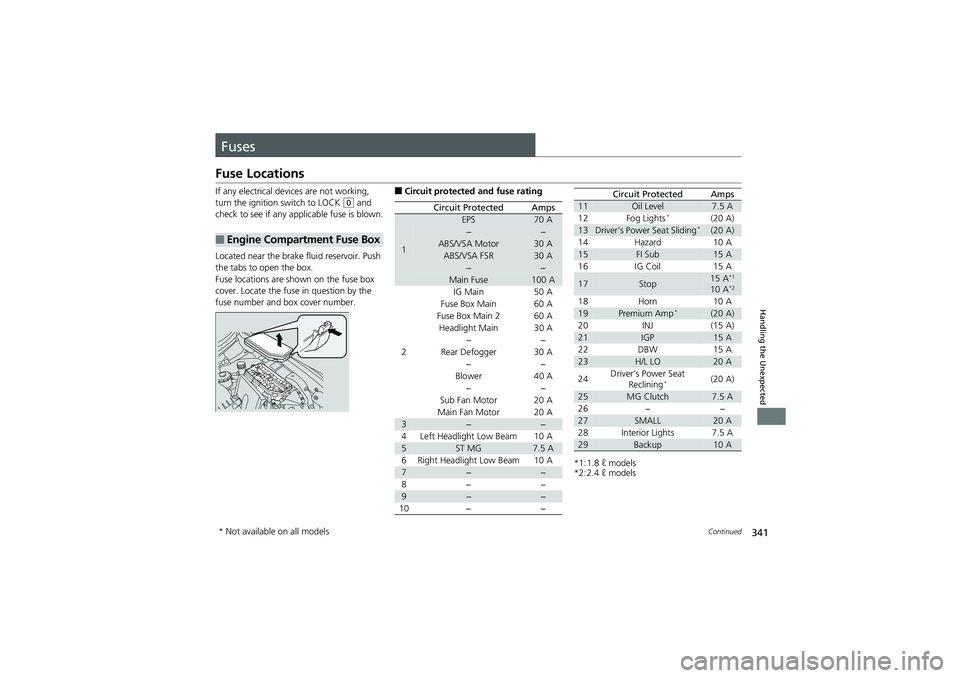
341Continued
Handling the Unexpected
Fuses
Fuse Locations
If any electrical devices are not working,
turn the ignition switch to LOCK
(0 and
check to see if any appl icable fuse is blown.
Located near the brake fluid reservoir. Push
the tabs to open the box.
Fuse locations are shown on the fuse box
cover. Locate the fuse in question by the
fuse number and box cover number.
■Engine Compartment Fuse Box
■Circuit protected and fuse rating
Circuit ProtectedAmps
1
EPS70 A
−−
ABS/VSA Motor30 A
ABS/VSA FSR30 A
−−
Main Fuse100 A
2
IG Main50 A
Fuse Box Main 60 A
Fuse Box Main 260 A
Headlight Main 30 A
−−
Rear Defogger 30 A −−
Blower 40 A −−
Sub Fan Motor 20 A
Main Fan Motor 20 A
3−−
4 Left Headlight Low Beam 10 A
5ST MG7.5 A
6 Right Headlight Low Beam 10 A
7−−
8− −
9−−
10 − −
*1:1.8 ℓ models
*2:2.4 ℓ models
11Oil Level7.5 A
12 Fog Lights*(20 A)
13Driver’s Power Seat Sliding*(20 A)
14 Hazard 10 A
15FI Sub15 A
16 IG Coil 15 A
17Stop15 A*1
10 A*2
18 Horn 10 A
19Premium Amp*(20 A)
20 INJ (15 A)
21IGP15 A
22 DBW 15 A
23H/L LO20 A
24 Driver’s Power Seat
Reclining
*(20 A)
25MG Clutch7.5 A
26 − −
27SMALL20 A
28 Interior Lights 7.5 A
29Backup10 A
Circuit ProtectedAmps
* Not available on all models
Page 344 of 368
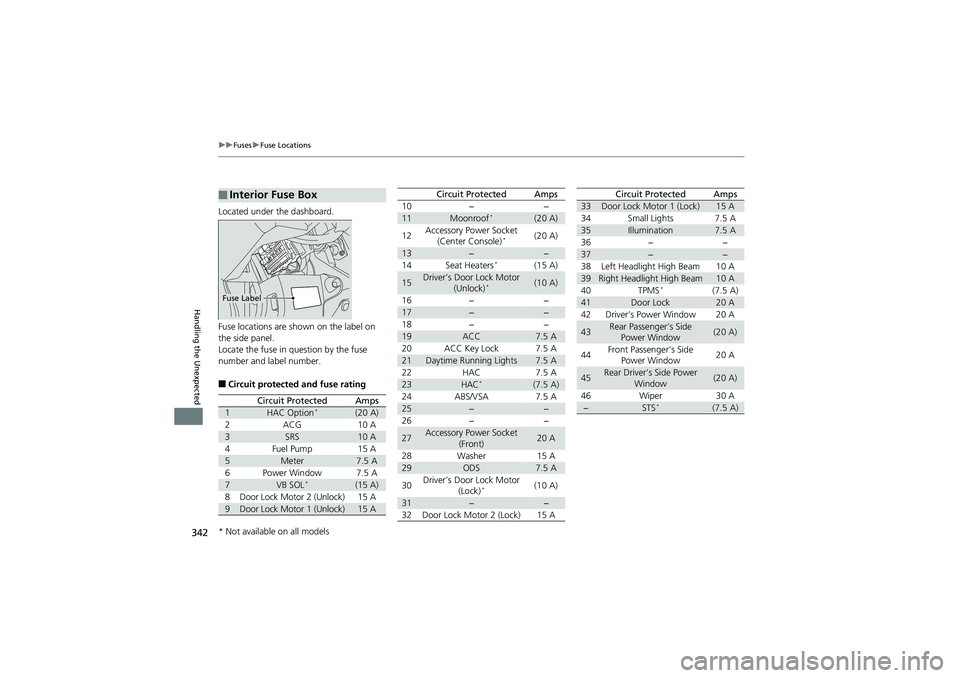
342
uuFuses uFuse Locations
Handling the Unexpected
Located under the dashboard.
Fuse locations are shown on the label on
the side panel.
Locate the fuse in question by the fuse
number and label number.
■Circuit protected and fuse rating
■Interior Fuse Box
Fuse Label
Circuit ProtectedAmps
1HAC Option*(20 A)
2ACG10 A
3SRS10 A
4Fuel Pump15 A
5Meter7.5 A
6Power Window7.5 A
7VB SOL*(15 A)
8Door Lock Motor 2 (Unlock)15 A
9Door Lock Motor 1 (Unlock)15 A
10−−
11Moonroof*(20 A)
12Accessory Power Socket
(Center Console)*(20 A)
13−−
14Seat Heaters*(15 A)
15Driver’s Door Lock Motor (Unlock)*(10 A)
16−−
17−−
18−−
19ACC7.5 A
20ACC Key Lock7.5 A
21Daytime Running Lights7.5 A
22HAC7.5 A
23HAC*(7.5 A)
24ABS/VSA7.5 A
25−−
26−−
27Accessory Power Socket
(Front)20 A
28Washer15 A
29ODS7.5 A
30Driver’s Door Lock Motor (Lock)*(10 A)
31−−
32Door Lock Motor 2 (Lock)15 A
Circuit ProtectedAmps
33Door Lock Motor 1 (Lock)15 A
34Small Lights7.5 A
35Illumination7.5 A
36−−
37−−
38Left Headlight High Beam10 A
39Right Headlight High Beam10 A
40TPMS*(7.5 A)
41Door Lock20 A
42Driver’s Power Window20 A
43Rear Passenger’s Side Power Window(20 A)
44Front Passenger’s Side Power Window20 A
45Rear Driver’s Side Power
Window(20 A)
46Wiper30 A
−STS*(7.5 A)
Circuit ProtectedAmps
* Not available on all models
Page 345 of 368
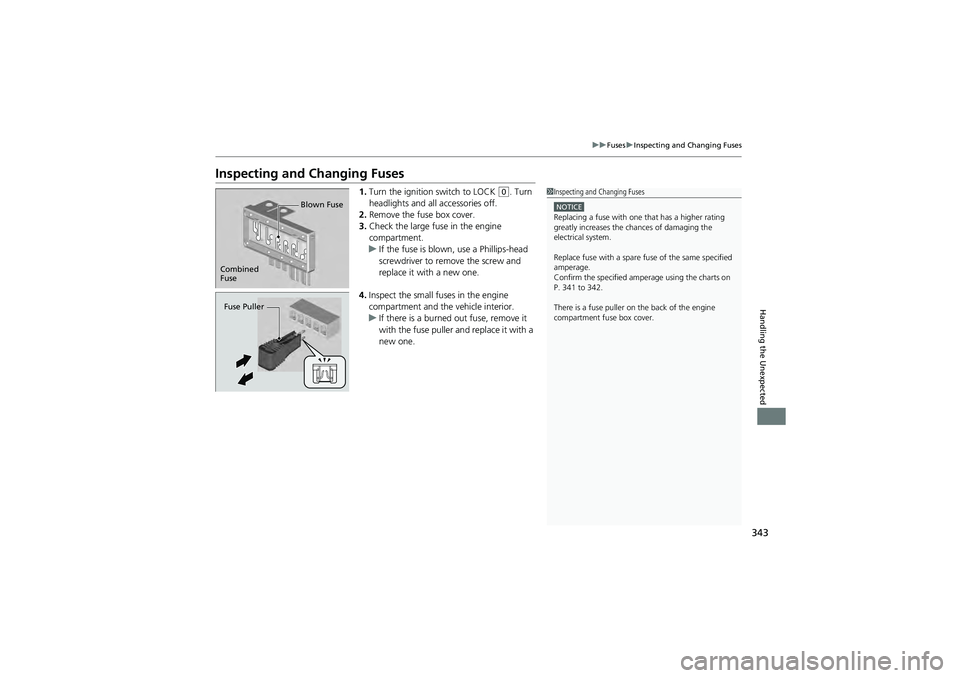
343
uuFuses uInspecting and Changing Fuses
Handling the Unexpected
Inspecting and Changing Fuses
1. Turn the ignition switch to LOCK (0. Turn
headlights and all accessories off.
2. Remove the fuse box cover.
3. Check the large fuse in the engine
compartment.
u If the fuse is blown, use a Phillips-head
screwdriver to remo ve the screw and
replace it with a new one.
4. Inspect the small fuses in the engine
compartment and the vehicle interior.
u If there is a burned out fuse, remove it
with the fuse puller an d replace it with a
new one.1 Inspecting and Changing Fuses
NOTICEReplacing a fuse with one that has a higher rating
greatly increases the chances of damaging the
electrical system.
Replace fuse with a spare fuse of the same specified
amperage.
Confirm the specified amperage using the charts on
P. 341 to 342.
There is a fuse puller on the back of the engine
compartment fuse box cover.
Combined
Fuse Blown Fuse
Fuse Puller
Page 346 of 368
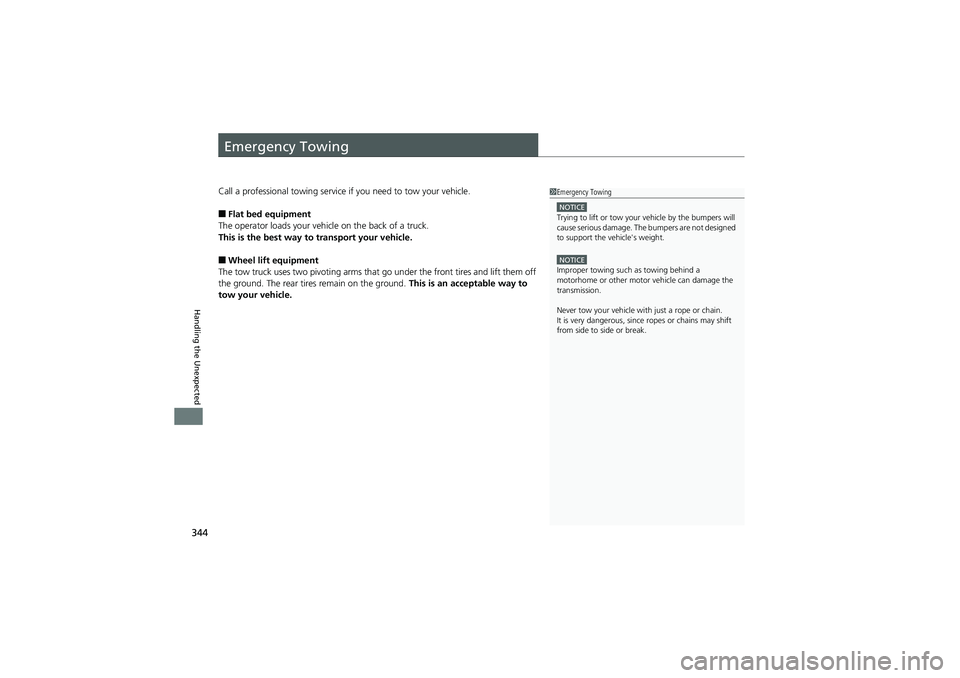
344
Handling the Unexpected
Emergency Towing
Call a professional towing service if you need to tow your vehicle.
■Flat bed equipment
The operator loads your vehicle on the back of a truck.
This is the best way to transport your vehicle.
■Wheel lift equipment
The tow truck uses two pivoting arms that go under the fr ont tires and lift them off
the ground. The rear tires remain on the ground. This is an acceptable way to
tow your vehicle.
1 Emergency Towing
NOTICETrying to lift or tow your vehicle by the bumpers will
cause serious damage. The bumpers are not designed
to support the vehicle's weight.
NOTICEImproper towing such as towing behind a
motorhome or other motor vehicle can damage the
transmission.
Never tow your vehicle with just a rope or chain.
It is very dangerous, since ropes or chains may shift
from side to side or break.
Page 347 of 368
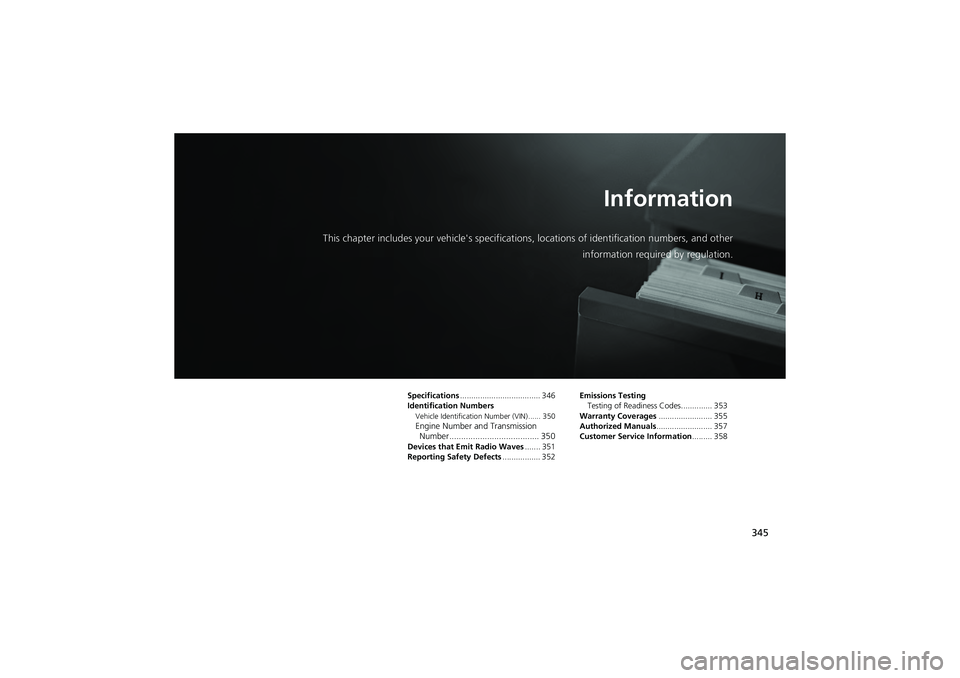
345
Information
This chapter includes your vehicle's specifications, locations of identification numbers, and otherinformation required by regulation.
Specifications.................................... 346
Identification Numbers
Vehicle Identification Number (VIN) ...... 350Engine Number and Transmission Number...................................... 350
Devices that Emit Radio Waves ....... 351
Reporting Safety Defects ................. 352Emissions Testing
Testing of Readiness Codes.............. 353
Warranty Coverages ........................ 355
Authorized Manuals ......................... 357
Customer Service Information......... 358
Page 348 of 368
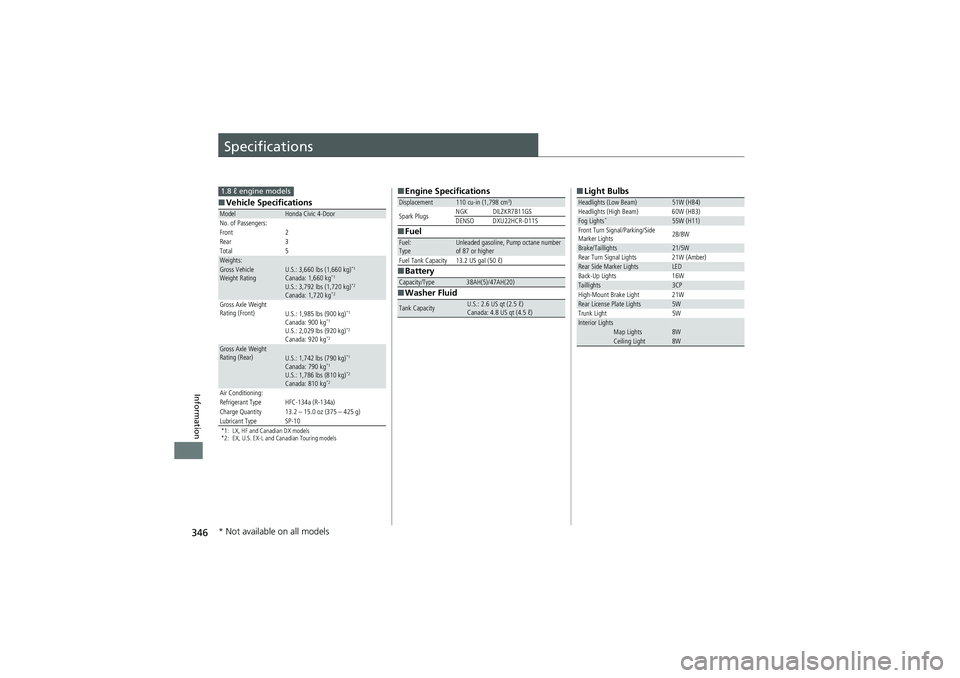
346
Information
Specifications
■Vehicle Specifications
*1: LX, HF and Canadian DX models
*2: EX, U.S. EX-L and Canadian Touring models
ModelHonda Civic 4-Door
No. of Passengers:
Front 2
Rear 3
Total 5
Weights:Gross Vehicle
Weight Rating U.S.: 3,660 lbs (1,660 kg)*1Canada: 1,660 kg*1U.S.: 3,792 lbs (1,720 kg)*2Canada: 1,720 kg*2
Gross Axle Weight
Rating (Front)U.S.: 1,985 lbs (900 kg)*1Canada: 900 kg*1U.S.: 2,029 lbs (920 kg)*2Canada: 920 kg*2
Gross Axle Weight
Rating (Rear)U.S.: 1,742 lbs (790 kg)*1Canada: 790 kg*1U.S.: 1,786 lbs (810 kg)*2Canada: 810 kg*2
Air Conditioning:
Refrigerant Type HFC-134a (R-134a)
Charge Quantity 13.2 – 15.0 oz (375 – 425 g)
Lubricant Type SP-10
1.8 ℓ engine models■ Engine Specifications
■ Fuel
■ Battery
■ Washer FluidDisplacement110 cu-in (1,798 cm3)
Spark Plugs NGK DILZKR7B11GS
DENSO DXU22HCR-D11S
Fuel:
TypeUnleaded gasoline, Pump octane number
of 87 or higher
Fuel Tank Capacity 13.2 US gal (50 ℓ)
Capacity/Type38AH(5)/47AH(20)
Tank CapacityU.S.: 2.6 US qt (2.5 ℓ)
Canada: 4.8 US qt (4.5 ℓ)
■ Light BulbsHeadlights (Low Beam)51W (HB4)
Headlights (High Beam) 60W (HB3)
Fog Lights*55W (H11)
Front Turn Signal/Parking/Side
Marker Lights 28/8W
Brake/Taillights21/5W
Rear Turn Signal Lights 21W (Amber)
Rear Side Marker LightsLED
Back-Up Lights 16W
Taillights3CP
High-Mount Brake Light 21W
Rear License Plate Lights5W
Trunk Light 5W
Interior LightsMap Lights8WCeiling Light8W
* Not available on all models
Page 349 of 368
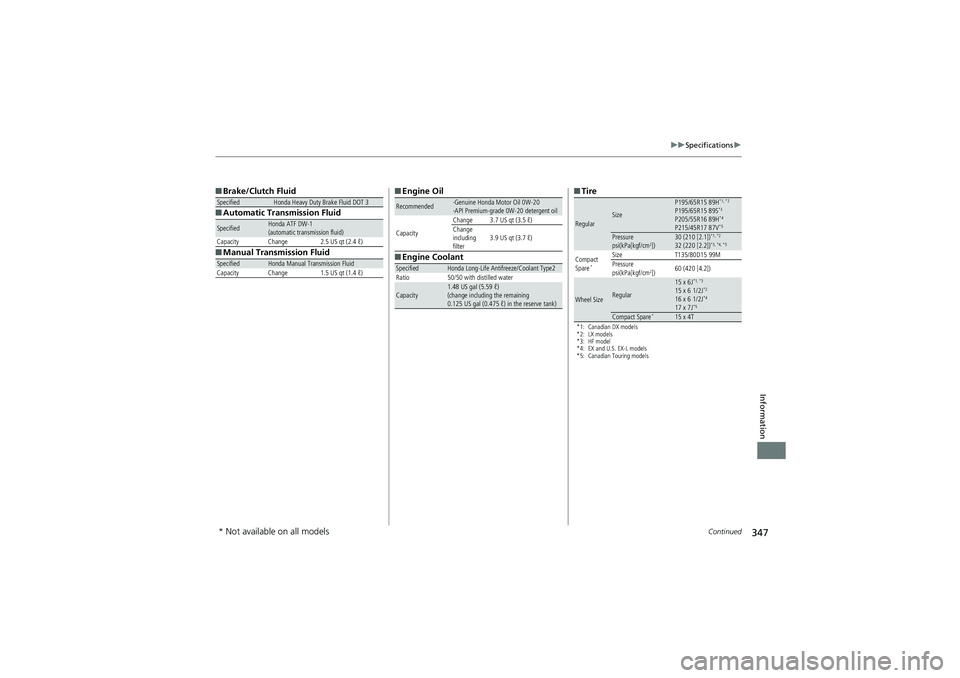
347
uuSpecifications u
Continued
Information
■Brake/Clutch Fluid
■ Automatic Transmission Fluid
■ Manual Transmission FluidSpecifiedHonda Heavy Duty Brake Fluid DOT 3
SpecifiedHonda ATF DW-1
(automatic transmission fluid)
Capacity Change 2.5 US qt (2.4 ℓ)
SpecifiedHonda Manual Transmission Fluid
Capacity Change 1.5 US qt (1.4 ℓ)
■ Engine Oil
■ Engine Coolant
Recommended·Genuine Honda Motor Oil 0W-20
·API Premium-grade 0W-20 detergent oil
Capacity Change 3.7 US qt (3.5 ℓ)
Change
including
filter
3.9 US qt (3.7 ℓ)
SpecifiedHonda Long-Life Antifreeze/Coolant Type2
Ratio 50/50 with distilled water
Capacity1.48 US gal (5.59 ℓ)
(change including the remaining
0.125 US gal (0.475 ℓ) in the reserve tank)
■ Tire
*1: Canadian DX models
*2: LX models
*3: HF model
*4: EX and U.S. EX-L models
*5: Canadian Touring models
RegularSize
P195/65R15 89H*1, *2P195/65R15 89S*3P205/55R16 89H*4P215/45R17 87V*5
Pressure
psi(kPa[kgf/cm2])30 (210 [2.1])*1, *232 (220 [2.2])*3, *4, *5
Compact
Spare*Size T135/80D15 99M
Pressure
psi(kPa[kgf/cm
2]) 60 (420 [4.2])
Wheel SizeRegular
15 x 6J*1, *315 x 6 1/2J*216 x 6 1/2J*417 x 7J*5
Compact Spare*15 x 4T
* Not available on all models
Page 350 of 368
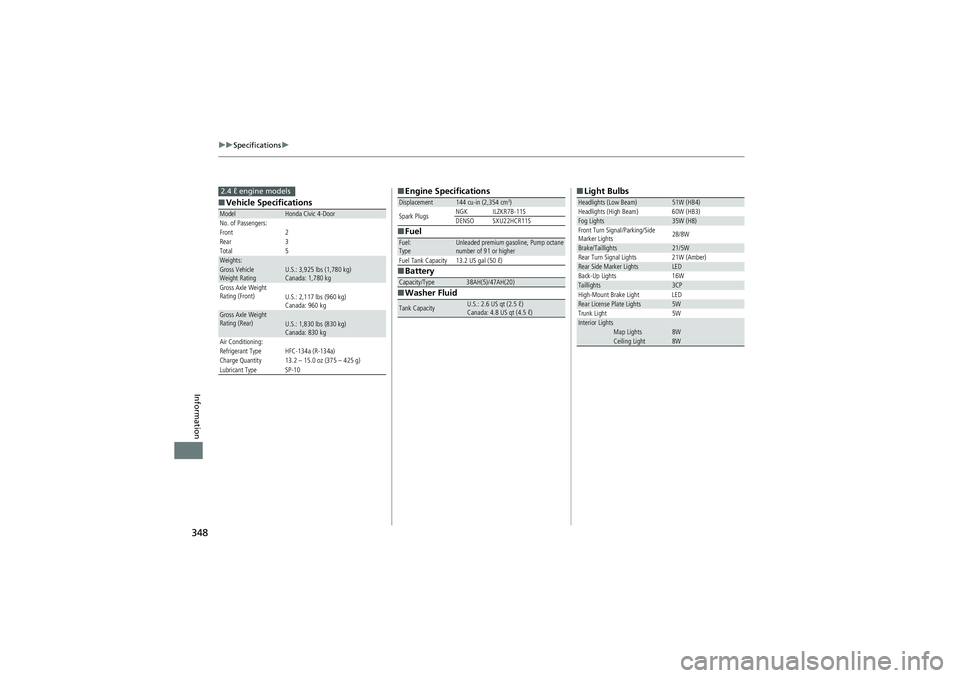
348
uuSpecifications u
Information
■Vehicle SpecificationsModelHonda Civic 4-Door
No. of Passengers:
Front 2
Rear 3
Total 5
Weights:Gross Vehicle
Weight Rating U.S.: 3,925 lbs (1,780 kg)
Canada: 1,780 kg
Gross Axle Weight
Rating (Front)U.S.: 2,117 lbs (960 kg)
Canada: 960 kg
Gross Axle Weight
Rating (Rear)U.S.: 1,830 lbs (830 kg)
Canada: 830 kg
Air Conditioning:
Refrigerant Type HFC-134a (R-134a)
Charge Quantity 13.2 – 15.0 oz (375 – 425 g)
Lubricant Type SP-10
2.4 ℓ engine models■ Engine Specifications
■ Fuel
■ Battery
■ Washer FluidDisplacement144 cu-in (2,354 cm3)
Spark Plugs NGK ILZKR7B-11S
DENSO SXU22HCR11S
Fuel:
TypeUnleaded premium gasoline, Pump octane
number of 91 or higher
Fuel Tank Capacity 13.2 US gal (50 ℓ)
Capacity/Type38AH(5)/47AH(20)
Tank CapacityU.S.: 2.6 US qt (2.5 ℓ)
Canada: 4.8 US qt (4.5 ℓ)
■ Light BulbsHeadlights (Low Beam)51W (HB4)
Headlights (High Beam) 60W (HB3)
Fog Lights35W (H8)
Front Turn Signal/Parking/Side
Marker Lights 28/8W
Brake/Taillights21/5W
Rear Turn Signal Lights 21W (Amber)
Rear Side Marker LightsLED
Back-Up Lights 16W
Taillights3CP
High-Mount Brake Light LED
Rear License Plate Lights5W
Trunk Light 5W
Interior LightsMap Lights8WCeiling Light8W